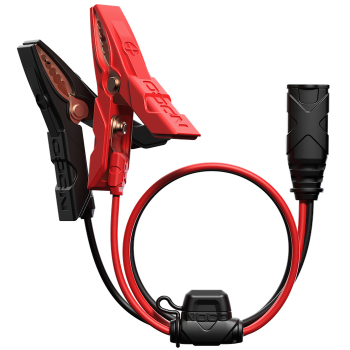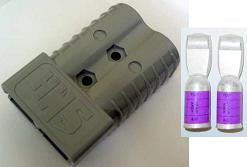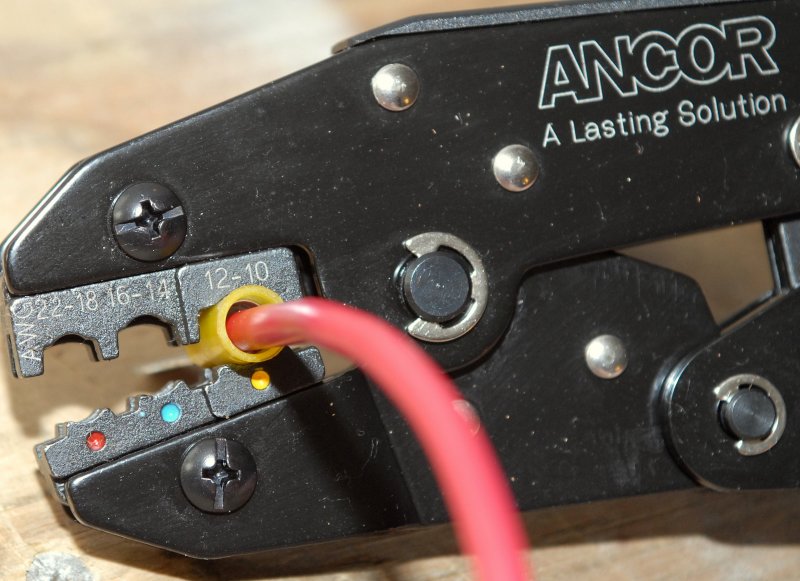Connecting the battery prior to plugging in the charger avoids sparking though correct?
Depends on the charger itself. I use adjustable voltage power supplies as manual chargers, and the 100 amp one will have a spark jump to fill the large capacitors within, the other 40 amp one does not, but I added an 'Ideal diode' to its output, to keep the Ammeter voltmeter columb counter and additional fans from running when I remove AC.
Generally, most smartchargers sold today have to have all the safety features, but a clamp ripped off a battery while still charging, inadvertently or not, can/will cause a spark, so its always best to unplug from the grid first and allow the battery to suck capacitors dry before clamp removal.
If one is in a quiet environment and rips a cableclamp off a battery while the charger is doing its thing, one can hear some components inside the charger protest at the sudden removal of load, especially when the charging source was outputting near its amperage limit into a depleted battery. This is cumulatively abusive, and a practice best avoided.
Generally 'the jumping spark' is most dangerous on a recently charged battery, at higher states of charge, that has been offgassing. But one with a shorted cell can also have a lot of hydrogen gas filling the tops of cells and in the general vicinity of the post.
The spark is why 'they' want jumper cables hooked up last, to a nearby ground, instead of the battery (-) itself.
This 'nearby ground' introduces resistance, and can make jumping more difficult, especially with poor quality cables/clamps or user error when clamping them. The existing battery to 'nearby ground' cables are often undersized, and compromised as well.
I've added huge Anderson power connectors in the middle of quality jumper cables before. Then one can clamp one half to one battery the other to the other battery then hook the Anderson connector together, and no spark can occur near either battery.
The Anderson contacts need a quality crimper. A hammer crimper does not qualify.
They go upto 4/0 and 450 amps, and I've have no fear doubling that max amp rating for a second or 3.
Anderson SB350 Connector 350 Amp 4/0 AWG Gray. This item is In Stock with Fast Free Shipping!

www.genuinedealz.com
Most starters for gassers, are rated in the 1.4KW output range, and use ~1800 watts input. if battery voltage drops to 10 during cranking, that is 180 amps. The higher the voltage the battery can maintain during cranking, the less amperage will be measured/required to turn the engine, and for lesser duration of that load too.
I've started my 5.2 liter v8 through a pair of anderson powerpoles 45 amp versions, without issue. 90 amps each, for under 2 seconds, I could not even feel heat from them. The Anderson 'powerpoles' 15/30/45 amp flavors whose plastic housings are identical and mate with each other, are different than the Anderson SB connectors, which are all different physical sizes. The 4/0 450 amp SB connector above is larger than the size of most men's palm.
Technically the 45 amp anderson powerpoles accept wire upto 10AWG thickness.
I fit 8AWG into them but have to destrand slightly at the contact, and then taper the wire insulation with a razor to be able to insert the crimped connector into the housing until it 'clicks'.
Alligator/parrot Clamps are necessary to have, but for more regular connections made or broken, they are best bypassed. IN my experience the best connector for DC connections is the Andersons, from 18AWG to 4/0.
They require proper crimping/ methods though.
To see what the marine guys consider proper:
Pick Your Crimp Tool FTZ 94284 & Ancor Hammer Crimper TEMCO TH0005 & FTZ Bench Mount BUY FTZ 94284 CRIMP TOOL - BAY MARINE
marinehowto.com
Marine Wire Termination - Tools of the Trade MHT Recommended Tools: The products below are our top picks for crimp tools. RecommendationsI include; PRO GRADE, MARINE GRADE, & PENNY SAVER GRADE. Every tool recommended BELOW, we have tested here.
marinehowto.com
In the Op's case I would use properly sized tinned copper ring terminals on the 1/2" nut which tightens the clamp on the battery post and use Anderson powerpoles. Even though he intends only to have maintenance chargers attached I'd use 8 or 10AWG to the powerpole from those posts.
The 15 amp anderson powerpole connectors are designed for thinner wire. but I tend to only buy 45 amp contacts designed for 10-12 gauge and fold the stripped wire over several times to 10-12 awg thickness then crimp, and use a few layers of adhesive lined heatshrink as wire stress relief and might even use Amazing goop or show goo on the backside wire entry as well.
I've got 45 amp andersons everywhere, on everything DC. They are not flawless and perfect, but I know of no connector that is. They are not waterproof but one can fill the wire entry end with liquid E tape or shoe goo, and the mating ends with dielectric grease, and achieve the same or better IP rating as 12v SAE connectors, and have a much lower resistance, much more reliable long term connector that can handle many thousand connect/disconnect cycles.
There are lots of Anderson connector clones on the market. One does not save significant $ by using them. I have purchased them ( powerpole clones, not SB), and they do mate side by side and to each other end to end without issue in my experience, but I recommend buying genuine Anderson.
Another option for 10AWG and thinner, and for those with good soldering skills and who are already not committed to Andersons, are the significantly less expensive HT60 connectors. Not having chose that road, I have no opinion on them, but know that others respect them.











